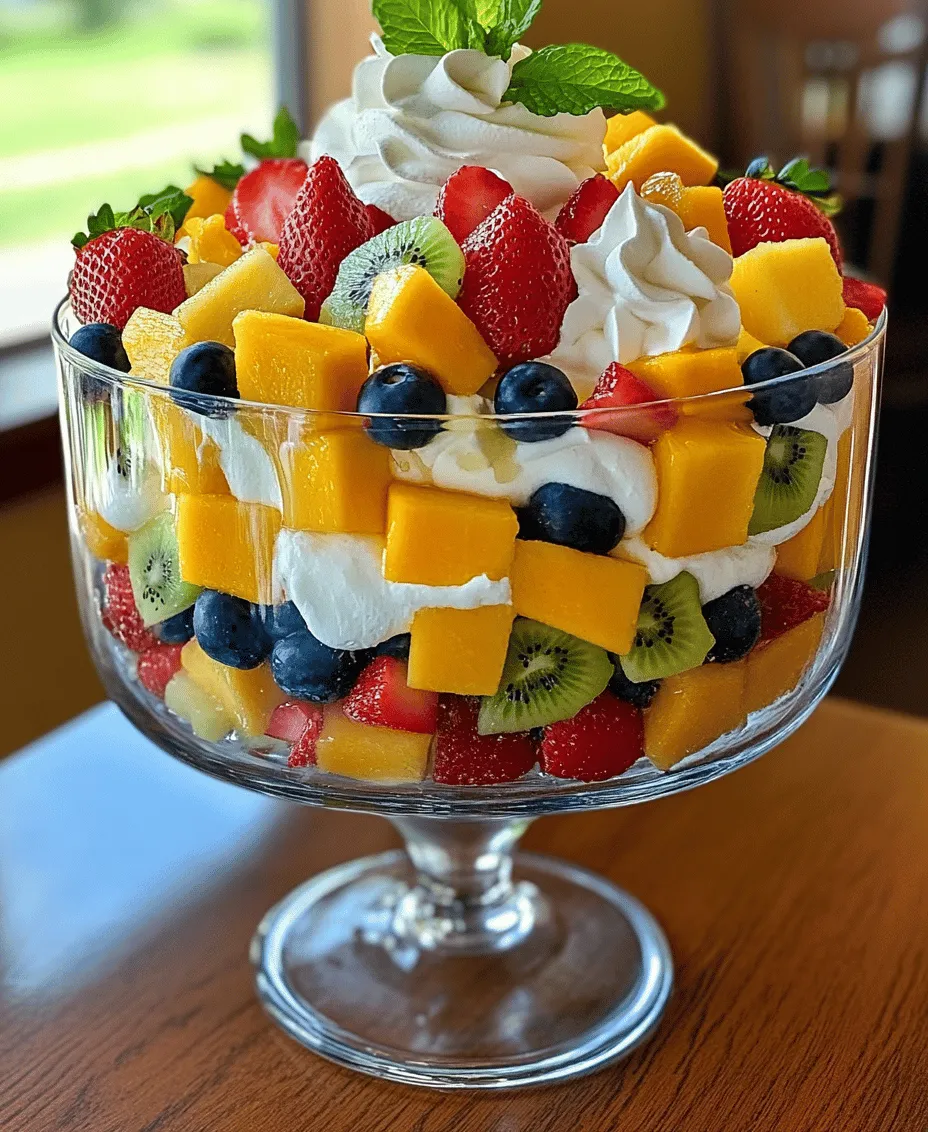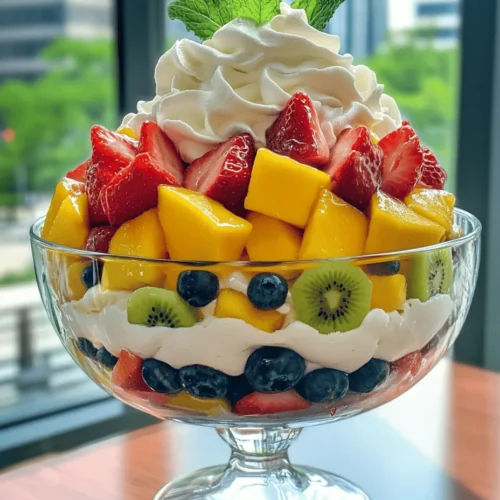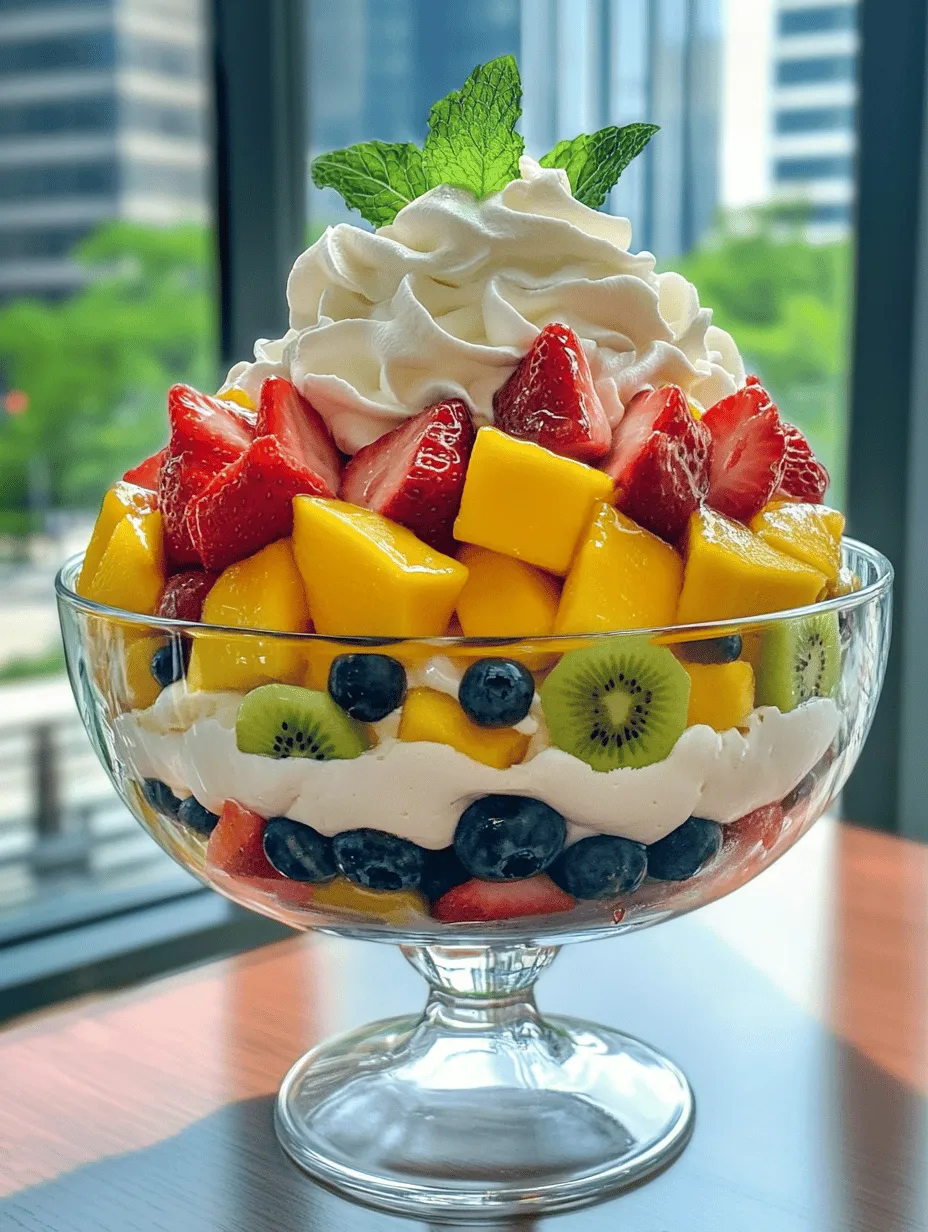Introduction
Trifles have long held a cherished place in dessert culture, beloved for their delightful appearance and the symphony of flavors they present. Originating from England, this classic dessert has evolved over the years, transforming into a versatile treat that can suit any occasion. From family gatherings to lavish celebrations, the trifle, with its layered beauty, never fails to impress. Among the myriad variations of this dessert, the Layered Delight Fruit Trifle stands out with its vibrant colors and refreshing taste, making it a favorite for dessert lovers.
At its core, the Layered Delight Fruit Trifle combines a medley of fresh fruits, soft cake, creamy pudding, and fluffy whipped cream. Each component contributes its unique texture and flavor, creating a harmonious dessert that tantalizes the taste buds. The balance of sweetness from the fruits, the lightness of the cake, the creaminess of the pudding, and the airy whipped cream makes each spoonful a delightful experience.
What makes this trifle particularly appealing is not only its taste but also its ease of preparation. Even novice cooks can assemble this dessert with confidence, making it an ideal choice for those who want to impress without spending hours in the kitchen. Whether you’re hosting a casual barbecue or a formal dinner party, the Layered Delight Fruit Trifle can adapt to any setting, bringing a touch of elegance and a burst of flavor to your table.
Understanding the Components of a Fruit Trifle
To fully appreciate the Layered Delight Fruit Trifle, it’s essential to understand the basic structure of a trifle and the role each component plays. A traditional trifle consists of four primary layers: fruits, cake, pudding, and whipped cream. Each layer not only adds depth to the dish but also contributes to the overall flavor and texture.
1. Fruits: The heart of the trifle, fruits offer a refreshing burst of flavor and vibrant color. Seasonal and local fruits not only taste better but also enhance the visual appeal of the dessert. Strawberries, blueberries, oranges, and bananas are popular choices, but feel free to experiment with your favorites.
2. Cake: A light sponge cake, such as angel food cake or pound cake, serves as the foundation of the trifle. Angel food cake is particularly favored for its airy texture, which allows it to absorb the flavors of the other components without becoming soggy. This balance is crucial in creating a layered dessert that holds its shape.
3. Pudding: Pudding adds a creamy element to the trifle, enriching the dessert with flavor and moisture. Vanilla pudding is a classic choice, but variations can be made using chocolate or even fruit-flavored puddings for a unique twist. The key is to achieve a smooth, velvety consistency that complements the other layers.
4. Whipped Cream: The final layer of whipped cream adds a light, airy finish to the trifle. It serves as a delightful contrast to the denser layers beneath. Homemade whipped cream can be flavored to enhance the overall taste, while store-bought versions offer convenience. The choice between the two often comes down to personal preference and time constraints.
The interplay of these components is what makes a trifle truly delightful. The sweetness of the fruits, the fluffiness of the cake, the creaminess of the pudding, and the lightness of the whipped cream create a multi-dimensional dessert that is as pleasurable to eat as it is to behold.
Selecting the Right Ingredients for Your Trifle
Creating an exceptional Layered Delight Fruit Trifle begins with selecting the right ingredients. Each component plays a vital role in the final flavor and texture of the dessert, so careful consideration is key.
– Mixed Fresh Fruits: When it comes to fruits, freshness is paramount. Seasonal and local options not only support local farmers but also provide superior flavor. Berries, stone fruits, and tropical fruits can all work beautifully in this trifle. For example, strawberries add a sweet-tart flavor, while peaches bring a juicy softness. Aim for a colorful assortment that will provide visual appeal in addition to taste.
– Angel Food Cake: Choosing a light cake is essential for a successful trifle. Angel food cake is a popular choice due to its airy texture and mild flavor. It absorbs the moisture from the pudding and fruits without becoming overly soggy. If you prefer a different flavor profile, consider using pound cake or even a flavored sponge cake, but keep in mind that denser cakes may alter the overall texture of the dessert.
– Vanilla Pudding: The pudding layer can be made from scratch or purchased ready-made. Homemade pudding offers the advantage of customizable flavor and thickness, while store-bought options provide convenience. If you opt for homemade, using high-quality vanilla extract will enhance the flavor significantly. Look for recipes that guide you in achieving the perfect consistency—smooth and creamy, without lumps.
– Whipped Cream: Whipped cream is often the crowning glory of a trifle. While store-bought whipped cream is convenient, making your own allows for better flavor control. To achieve the ideal texture, it’s important to start with cold cream and use a chilled bowl for whipping. Adding a touch of sugar and vanilla extract can elevate the flavor profile. If you’re looking for alternatives, consider using whipped topping or even a dairy-free version made from coconut cream.
– Optional Ingredients: For those with a sweet tooth, consider enhancing your trifle with honey or maple syrup. These natural sweeteners can be drizzled over the layers to intensify the flavor without overpowering the freshness of the fruits. Additionally, consider incorporating yogurt or mascarpone cheese for added creaminess and a slight tang.
Step-by-Step Preparation of Layered Delight Fruit Trifle
With the right ingredients in hand, it’s time to dive into the preparation of the Layered Delight Fruit Trifle. This step-by-step guide will ensure you create a stunning dessert that will be the centerpiece of any gathering.
Preparing the Fruit
Start by washing and cutting your chosen fruits. This step is crucial not only for presentation but also for maximizing flavor.
1. Washing: Rinse all fruits thoroughly under cold water to remove any dirt or pesticides. For berries, consider soaking them briefly in a vinegar solution to ensure they’re clean.
2. Cutting: For larger fruits, such as strawberries and peaches, slice them into bite-sized pieces. Aim for uniformity in size to create a visually appealing layered effect. For the berries, you can leave them whole or halve them, depending on your preference.
3. Mixing: In a bowl, gently combine the prepared fruits. If desired, drizzle a bit of honey or sprinkle some sugar over them to enhance their natural sweetness, especially if they’re not quite ripe.
Making the Pudding
Next, turn your attention to the pudding layer. If you’re making it from scratch, follow these detailed instructions for a smooth and creamy result.
1. Ingredients: Gather your ingredients: milk, sugar, cornstarch, and vanilla extract.
2. Mixing the Dry Ingredients: In a medium saucepan, whisk together the sugar and cornstarch. This will help prevent lumps from forming when you add the milk.
3. Heating: Gradually pour in the milk while whisking continuously. Place the saucepan over medium heat and continue to stir until the mixture begins to thicken. This process usually takes about 5-10 minutes.
4. Flavoring: Once thickened to your desired consistency, remove the pan from heat and stir in the vanilla extract. Allow the pudding to cool slightly before using it in your trifle.
5. Chilling: For the best texture, cover the pudding with plastic wrap, pressing it directly onto the surface to prevent a skin from forming. Refrigerate until you are ready to assemble the trifle.
Whipping the Cream
The final step in preparation is whipping the cream. This process is simple but requires attention to detail to achieve the perfect texture.
1. Chilling: Before you begin, ensure your mixing bowl and beaters are chilled. Place them in the refrigerator for about 15 minutes.
2. Whipping: Pour cold heavy cream into the chilled bowl. Begin whipping on low speed, gradually increasing to medium-high.
3. Adding Sugar: When the cream starts to thicken, add powdered sugar and a splash of vanilla extract. Continue whipping until soft peaks form. Be careful not to over-whip, as this can lead to a grainy texture.
4. Texture Check: The whipped cream should be light and fluffy, holding its shape without being overly stiff.
With all your components prepared, you are now ready to assemble your Layered Delight Fruit Trifle. Each layer will come together to create a stunning dessert that is sure to delight your guests and leave a lasting impression. Stay tuned for the next steps on how to beautifully layer these ingredients and present your trifle like a true culinary masterpiece!

Layering the Trifle: Best Practices for Layering
Creating a beautifully layered fruit trifle involves more than just stacking ingredients haphazardly. To ensure even distribution of flavors and maintain a visually appealing presentation, follow these best practices:
1. Start with the Base: Begin by spooning a layer of the cake or cookie base into your serving vessel. Ensure this initial layer is evenly spread to support the subsequent layers. This foundation is crucial for stability.
2. Add Pudding Evenly: After your base, carefully pour or spoon in an even layer of pudding. Using a spatula can help you spread it smoothly across the cake layer without disturbing it.
3. Layering Fruits: When it comes to fruits, cut them into uniform pieces for consistent flavor and texture distribution. Alternate between larger and smaller fruits to create visual interest. For example, layer strawberries with blueberries and banana slices.
4. Whipped Cream Layer: The whipped cream should be fluffy and light. Use a piping bag for a more decorative and even distribution over the fruits and puddings. This not only looks appealing but also ensures every bite has the perfect amount of creaminess.
5. Repeat the Layers: Continue the layering process until you reach the top of your serving vessel. Be sure to end with a layer of whipped cream to create a beautiful finish.
6. Chill Before Serving: Allow the trifle to chill in the refrigerator for at least two hours before serving. This helps the flavors meld together and makes for easier slicing.
Creative Variations on the Classic Trifle Recipe
While the classic Layered Delight Fruit Trifle is a hit, exploring variations can elevate your dessert game. Here are some creative twists to consider:
– Alternative Fruits: Depending on the season, you can swap out fruits. In summer, try peaches, berries, and cherries. In the fall, consider apples and pears, perhaps even adding a hint of cinnamon for warmth.
– Different Cake Options: The choice of base can greatly affect the flavor and texture. While traditional sponge cake is a favorite, you might experiment with brownies for a rich chocolate experience, or use gluten-free cake options made from almond or coconut flour for those with dietary restrictions.
– Flavor Variations for Pudding: Don’t limit yourself to vanilla pudding. Chocolate pudding adds a decadent twist, while coconut pudding can offer a tropical flair. For a fruity touch, consider lemon or banana-flavored pudding.
– Customizing Whipped Cream: Elevate your whipped cream by adding spices like cinnamon, nutmeg, or even a splash of vanilla extract. For a more adventurous flavor, incorporate a dash of almond extract or a swirl of your favorite fruit puree.
Presentation Tips for Your Layered Delight Fruit Trifle
Presentation is key when it comes to desserts, especially for something as visually stunning as a trifle. Here are some tips to ensure your trifle looks as good as it tastes:
– Choosing the Right Serving Vessel: A traditional trifle bowl allows for a beautiful view of the layers, making it a great centerpiece. However, for individual servings, consider clear cups or small mason jars. These not only make serving easier but also add a rustic charm.
– Garnishing Options: To finish your trifle, consider garnishing with fresh mint leaves, edible flowers, or strategically placed fruit slices on top. This adds a pop of color and sophistication.
– Photography and Styling: If you plan to share your creation on social media, pay attention to lighting and background. Natural light works best for food photography. Style your trifle with complementary colors, and don’t forget to capture those beautiful layers!
The Ideal Occasions for Serving Layered Delight Fruit Trifle
One of the best aspects of the Layered Delight Fruit Trifle is its versatility. Here are some occasions where this dessert truly shines:
– Celebrating Special Events: Birthdays, anniversaries, and holidays call for desserts that feel festive. The colorful layers of a trifle make it a perfect choice for celebrations.
– Casual Gatherings: During summer barbecues or casual potlucks, a trifle can be a refreshing and shareable dessert option that appeals to both kids and adults.
– Themed Parties: Tailor your trifle to fit a theme. For instance, a beach party could feature tropical fruits and coconut pudding, while a fall gathering might highlight apples and pumpkin spice whipped cream.
Nutritional Considerations of the Layered Delight Fruit Trifle
While the Layered Delight Fruit Trifle is undoubtedly a treat, it also has some nutritional benefits thanks to the fresh fruits. Here are a few considerations:
– Health Benefits of Fresh Fruits: Fruits are packed with vitamins, fiber, and antioxidants. Berries, for instance, are known for their high levels of antioxidants, while bananas provide potassium. Incorporating a variety of fruits can enhance the nutritional profile of your dessert.
– Portion Control: While trifles are rich and indulgent, they can be enjoyed in moderation. Offering smaller servings can help with portion control, allowing your guests to enjoy the flavors without overindulging.
– Balancing Dessert with a Healthy Diet: It’s all about balance. This dessert can fit into a healthy eating plan, especially when paired with wholesome ingredients and enjoyed on special occasions. Encourage guests to savor each bite, making it a mindful indulgence.
Conclusion
The Layered Delight Fruit Trifle is not just a dessert; it’s a celebration of flavors, colors, and creativity. Its versatility allows for endless customization, making it a canvas for your culinary expression. Whether you stick to traditional ingredients or explore innovative variations, this trifle is sure to impress.
As you embark on your trifle-making journey, don’t hesitate to experiment with flavors and ingredients to make the recipe your own. Remember, cooking is as much about personal expression as it is about following a recipe. Share this delightful dessert with loved ones and create sweet memories that will last a lifetime. Enjoy every layer, every flavor, and the joy of sharing something special!



